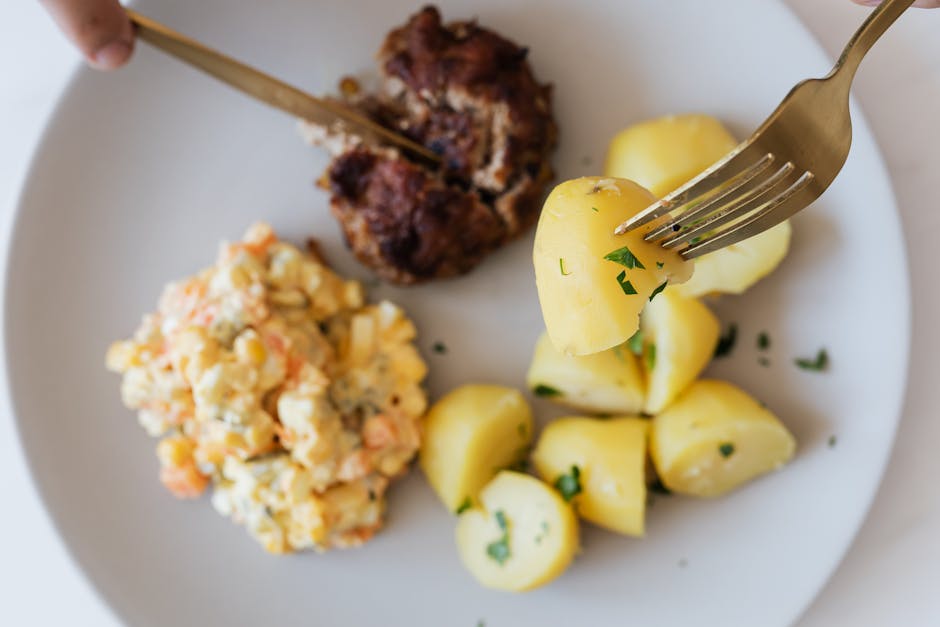
The humble boiled potato. It’s a culinary chameleon, a blank canvas upon which countless flavors can be painted. Often overlooked, the perfectly cooked boiled potato is a thing of simple beauty, a testament to the power of quality ingredients and careful technique. This article will guide you through the process of creating the best boiled potatoes you’ve ever tasted, from selecting the right potatoes to achieving that tender, fluffy interior and a subtly firm exterior. We’ll delve into the nuances of boiling, explore various serving suggestions, and offer tips and tricks to ensure your boiled potato creations are consistently successful. Whether you’re a seasoned chef or a kitchen novice, this guide will empower you to elevate your boiled potato game.
Before we dive into the recipe, let’s talk about the versatility of the boiled potato. It’s a foundational element in numerous dishes worldwide, from the classic potato salad to hearty stews and comforting side dishes. The boiled potato is a versatile ingredient, capable of absorbing flavors from its accompanying ingredients, making it a great choice for a wide variety of dishes. Mastering the art of boiling potatoes is a fundamental skill for any home cook, and one that will serve you well in countless culinary adventures. The boiled potato is a staple, a comfort food, and a testament to the fact that sometimes, the simplest dishes are the most satisfying. This recipe focuses on the fundamental process of boiling the perfect potato.
Image Placeholder: (Imagine a high-quality, mouth-watering photo here of perfectly boiled potatoes, perhaps seasoned with herbs and a pat of butter. The image should showcase the fluffy interior and slightly firm exterior.)
| Category | Value |
|---|---|
| Preparation Time | 10 minutes |
| Cooking Time | 15-20 minutes |
| Servings | 4 servings |
| Difficulty | Easy |
Nutrition Information (per serving, approximate):
- Calories: 160
- Protein: 4g
- Fat: 0.1g
- Carbohydrates: 36g
- Fiber: 4g
- Sugar: 2g
Ingredients:
| Ingredient | Quantity |
|---|---|
| Potatoes (Yukon Gold or Russet recommended) | 1.5 lbs |
| Water | Enough to cover potatoes |
| Salt | 1 tablespoon (or to taste) |
| Optional: Fresh herbs (parsley, chives, dill) | As needed, for garnish |
| Optional: Butter or olive oil | To taste, for serving |
| Optional: Black Pepper | To taste |
Cooking Instructions
- Prepare the Potatoes: Wash the potatoes thoroughly under cold running water to remove any dirt. You can peel the potatoes if you prefer, but the skins add texture and nutrients. For this recipe, we recommend leaving the skins on for extra fiber and flavor. If peeling, use a vegetable peeler to remove the skin.
- Cut the Potatoes (Optional): If the potatoes are large, cut them into roughly equal-sized pieces. This ensures even cooking. Aim for pieces that are about 1.5-2 inches in size. Smaller potatoes can be boiled whole.
- Place Potatoes in a Pot: Place the prepared potatoes in a large pot.
- Add Water and Salt: Cover the potatoes completely with cold water. Add the salt. The salt is crucial for seasoning the potatoes from the inside out. The water should be at least an inch above the potatoes.
- Bring to a Boil: Place the pot over high heat and bring the water to a rolling boil.
- Reduce Heat and Simmer: Once boiling, reduce the heat to a gentle simmer. This prevents the potatoes from breaking apart.
- Cook Until Tender: Cook the potatoes for approximately 15-20 minutes, or until they are easily pierced with a fork or knife. The cooking time will vary depending on the size of the potatoes. Check for doneness by inserting a fork or knife into the center of a potato. If it slides in easily, they are done.
- Drain the Potatoes: Carefully drain the potatoes in a colander.
- Return to Pot (Optional): Return the drained potatoes to the pot and let them sit for a minute or two to allow any excess moisture to evaporate. This will help them become slightly fluffy.
- Season and Serve: Season the boiled potatoes with salt, pepper, and your preferred toppings. This could include butter, olive oil, fresh herbs (parsley, chives, or dill), sour cream, or any other desired additions. Serve immediately.
Serving Suggestions:
- As a Side Dish: Serve the boiled potatoes alongside grilled meats, roasted vegetables, or fish. A simple pat of butter and a sprinkle of fresh herbs is often all you need.
- Potato Salad: Cube the boiled potatoes and use them as the base for a classic potato salad. Mix with mayonnaise, mustard, celery, onions, and hard-boiled eggs.
- Mashed Potatoes: Mash the boiled potatoes with butter, milk or cream, and seasonings for a creamy and comforting side.
- Potato Hash: Dice the boiled potatoes and sauté them with onions, peppers, and your favorite seasonings for a hearty potato hash.
- In Stews and Soups: Add the boiled potatoes to stews and soups for extra heartiness and flavor.
- Roasted Potatoes: Toss boiled potatoes with olive oil, herbs, and spices, and roast them in the oven until golden brown and crispy.
Notes and Tips:
- Potato Selection: The type of potato you choose will affect the texture. Yukon Gold potatoes are excellent for boiling, as they have a creamy texture. Russet potatoes are also a good choice, offering a fluffier texture. Waxy potatoes, like red potatoes, hold their shape well and are good for potato salads.
- Salt is Key: Don’t skimp on the salt. Salting the water seasons the potatoes from the inside out, enhancing their flavor.
- Don’t Overcook: Overcooked potatoes can become mushy. Keep a close eye on them and test for doneness frequently.
- Even Sizing: If you’re cutting the potatoes, try to cut them into similarly sized pieces for even cooking.
- Resting Time: Allowing the boiled potatoes to sit in the pot for a minute or two after draining can help them dry out slightly, resulting in a fluffier texture.
- Flavor Enhancements: Experiment with adding herbs, spices, or aromatics to the boiling water. Bay leaves, garlic cloves, or peppercorns can add subtle flavor notes.
- Cooling for Potato Salad: If you’re making potato salad, allow the boiled potatoes to cool completely before mixing them with the other ingredients to prevent the salad from becoming soggy.
- Storage: Leftover boiled potatoes can be stored in the refrigerator for up to 3 days.
Boiled potatoes, despite their simplicity, are a culinary delight. They are a testament to the fact that even the most basic ingredients can be transformed into something truly special with the right techniques. By following these steps, you’ll be able to prepare perfectly cooked boiled potatoes every time, and with a little creativity, you can use them as the foundation for countless delicious meals. The boiled potato is a versatile side dish, and you can dress it up or down depending on your preference. The boiled potato is a classic for a reason; it provides a great canvas for a variety of flavors. Enjoy your perfectly cooked boiled potatoes!
The versatility of the boiled potato cannot be overstated. From rustic side dishes to elegant culinary creations, the boiled potato provides a foundation for a wide range of flavors and textures. The boiled potato is a culinary staple, so mastering this simple recipe is a must for any cook. The boiled potato is a comfort food, and it is a dish that everyone can enjoy.
The boiled potato is a fantastic way to use fresh potatoes, and it’s a great way to add a healthy dose of carbohydrates and fiber to your diet. The boiled potato is a healthy and satisfying food. Try different potato varieties to find your favorites. The boiled potato is a blank canvas for all kinds of flavors.
Experiment with different seasonings and toppings to create unique and exciting flavor combinations with your boiled potatoes. The boiled potato is a perfect side to any meal.
Enjoy the simple pleasure of a perfectly cooked boiled potato!

